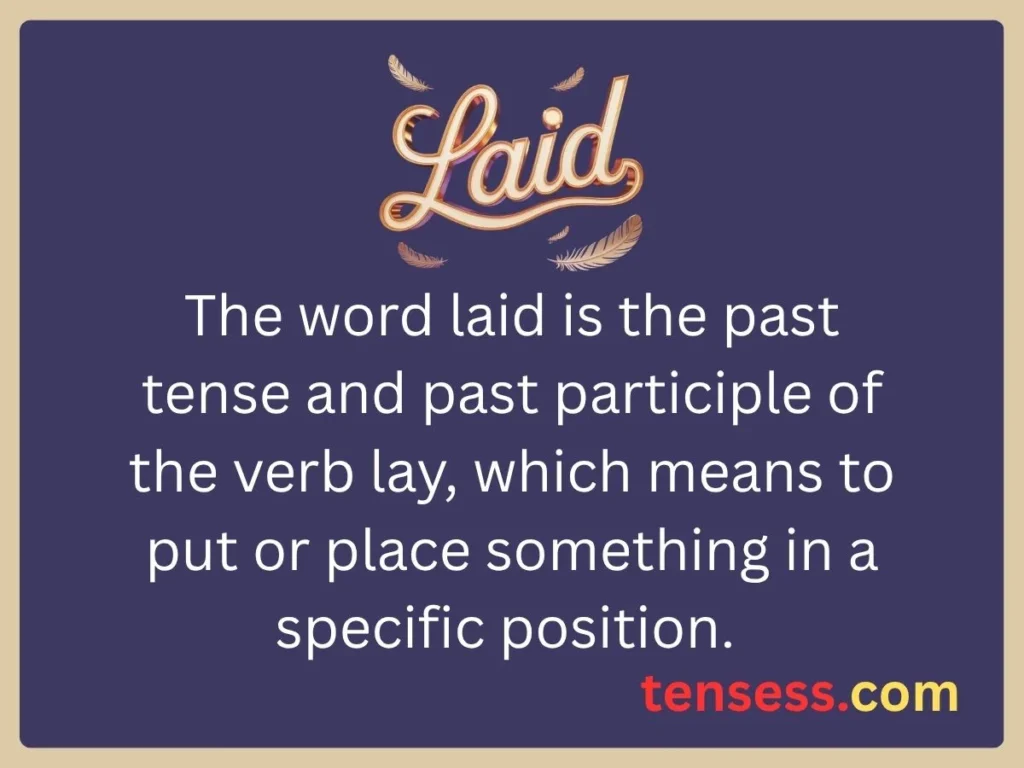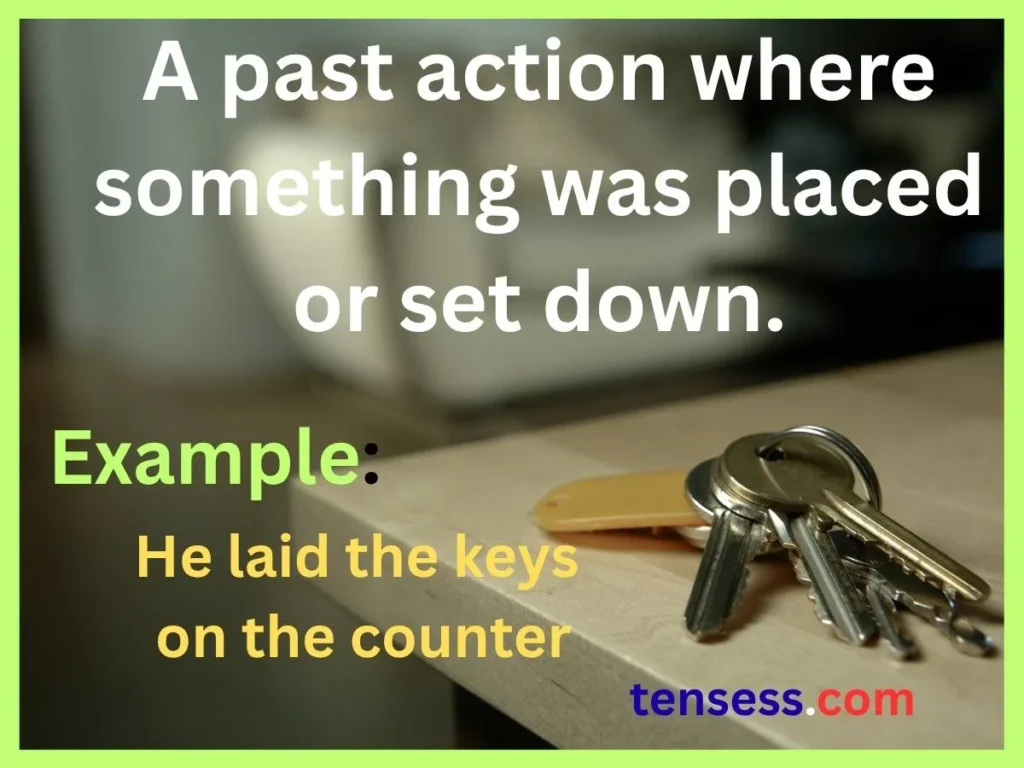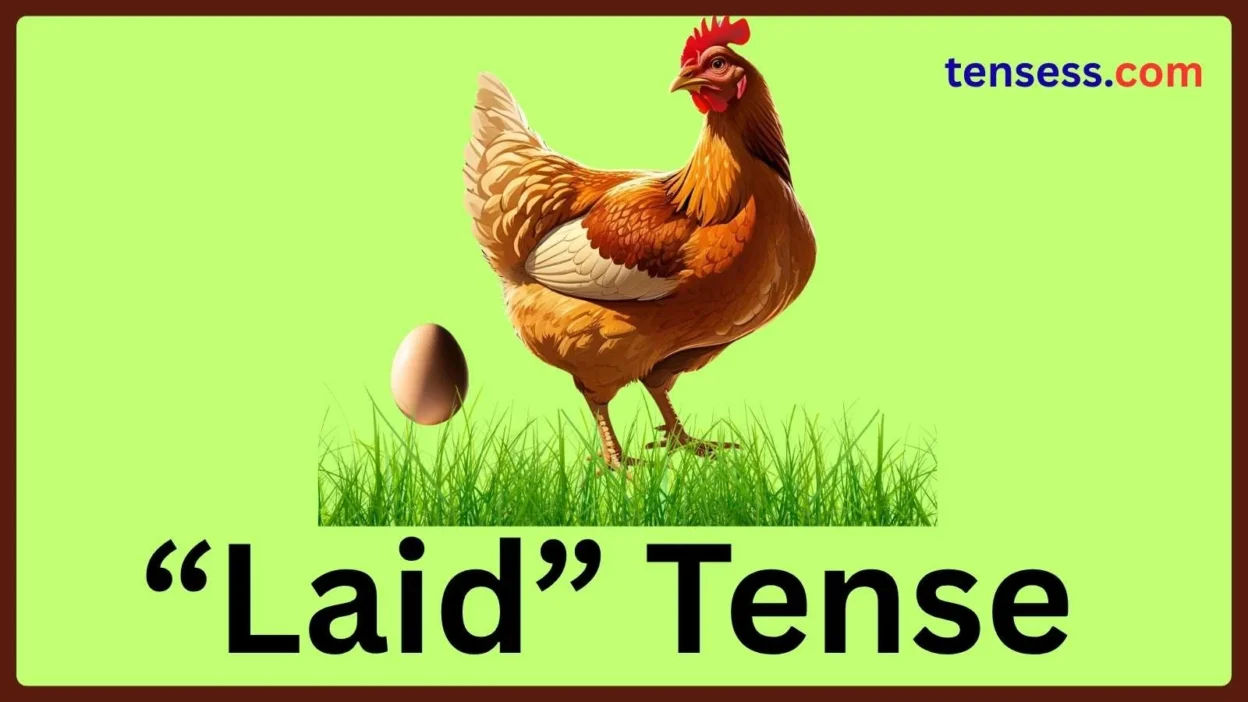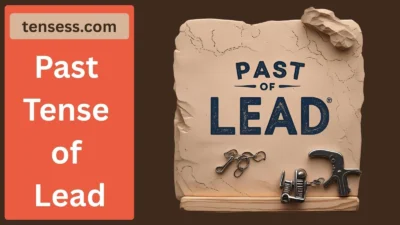The past tense of lay, which is laid, is a crucial concept for students, language learners, writers, and grammar enthusiasts.
Understanding how to use laid correctly can enhance your writing and communication skills.
The verb lay means to place something down, and its past tense, laid, is often confused with similar verbs like lie.
This SEO-optimized guide will break down the definition, structure, and usage of laid in a beginner-friendly way.
With clear explanations, real-life verb tense examples, and practical tips, you’ll master laid in no time.
Whether you’re crafting a story or polishing an essay, this article offers skimmable sections, tables, and exercises to make learning engaging and fun.
What Is the “Laid” Tense?

Unlike lie (to recline), lay requires a direct object. For example, you lay a book on the table, but you lie down on a bed.
Laid is used to describe actions that happened in the past, such as “She laid the blanket on the couch yesterday.”
This irregular verb doesn’t follow the standard “-ed” ending for past tense, making it essential to understand its unique conjugation.
How to Recognize?

To recognize laid in a sentence, look for:
- A direct object (e.g., “the book,” “the pen”) following the verb.
- No “-ed” ending, as lay is irregular, becoming laid in the past.
For instance, “He laid the keys on the counter” shows a completed action with a direct object (keys).
Structure of Sentence

The sentence structure for laid typically follows this pattern:
- Subject: The doer (e.g., I, she, they).
- Laid: The past tense verb.
- Direct object: The thing being placed (e.g., plates, book).
- Additional details: Optional, like time or place (e.g., for dinner, yesterday).
Formation
The formation of laid is straightforward since it’s the past tense of lay. It doesn’t change based on the subject (I, you, he, etc.). For example:
- I laid the foundation.
- They laid the groundwork.
No helping verbs are needed for simple past tense, but laid can pair with have/has/had in perfect tenses (e.g., “I have laid the table”).
Verbs
The verb lay belongs to the irregular verb family, where the past tense and past participle are laid. Unlike regular verbs (e.g., walk → walked), lay doesn’t take “-ed.” Related verbs like set or place follow similar patterns but may differ in conjugation.
Helping Verbs
In simple past tense, laid doesn’t require helping verbs. However, in perfect tenses:
- Have/has laid is used for present perfect (e.g., “She has laid the table”).
- Had laid is used for past perfect (e.g., “They had laid the foundation before the storm”).
These auxiliaries clarify the timing of the action.
Explanation of Some Verbs with Reference to “Laid”
Verbs like set, place, and put share similarities with lay because they involve placing something. However:
- Set: Past tense is set (e.g., “She set the vase on the shelf”).
- Place: Past tense is placed (e.g., “He placed the cup on the table”).
- Put: Past tense is put (e.g., “I put the keys on the counter”).
Unlike lay, place is regular, while set and put are irregular like lay. Always ensure laid has a direct object, unlike lie (past tense: lay).
Table of Some Regular or Irregular Verbs in “Laid” Tense
| Base Verb | Past Tense | Past Participle | Regular/Irregular |
| Lay | Laid | Laid | Irregular |
| Set | Set | Set | Irregular |
| Put | Put | Put | Irregular |
| Place | Placed | Placed | Regular |
| Spread | Spread | Spread | Irregular |
Simple Sentence Examples
- I laid the book on the desk.
- She laid the baby in the crib.
- They laid the carpet in the living room.
- He laid the tools on the workbench.
- We laid the picnic blanket on the grass.
- You laid the papers on the table.
- It laid an egg in the nest.
- The workers laid bricks for the wall.
- Sarah laid her jacket on the chair.
- The chef laid ingredients on the counter.
Negative Sentence Examples
- I didn’t lay the book on the desk.
- She didn’t lay the baby in the crib.
- They didn’t lay the carpet in the living room.
- He didn’t lay the tools on the workbench.
- We didn’t lay the picnic blanket on the grass.
- You didn’t lay the papers on the table.
- It didn’t lay an egg in the nest.
- The workers didn’t lay bricks for the wall.
- Sarah didn’t lay her jacket on the chair.
- The chef didn’t lay ingredients on the counter.
Interrogative Sentence Examples
- Did I lay the book on the desk?
- Did she lay the baby in the crib?
- Did they lay the carpet in the living room?
- Did he lay the tools on the workbench?
- Did we lay the picnic blanket on the grass?
- Did you lay the papers on the table?
- Did it lay an egg in the nest?
- Did the workers lay bricks for the wall?
- Did Sarah lay her jacket on the chair?
- Did the chef lay ingredients on the counter?
Negative and Interrogative Sentence Examples
- Didn’t I lay the book on the desk?
- Didn’t she lay the baby in the crib?
- Didn’t they lay the carpet in the living room?
- Didn’t he lay the tools on the workbench?
- Didn’t we lay the picnic blanket on the grass?
- Didn’t you lay the papers on the table?
- Didn’t it lay an egg in the nest?
- Didn’t the workers lay bricks for the wall?
- Didn’t Sarah lay her jacket on the chair?
- Didn’t the chef lay ingredients on the counter?
How to Conjugate “Laid” Tense
Since laid is the past tense of lay, it remains the same for all subjects (I, you, he, she, it, we, they). Here’s how to use it:
- Use laid for simple past (e.g., “I laid the book down”).
- Pair with have/has for present perfect (e.g., “She has laid the table”).
- Use had for past perfect (e.g., “They had laid the foundation”).
- Ensure a direct object follows laid.
- Avoid confusing with lie (to recline).
- Use did for questions (e.g., “Did you lay it down?”).
- Use didn’t for negatives (e.g., “I didn’t lay it there”).
- Keep the verb form laid consistent.
- Practice with different subjects.
- Check for context (past action).
Conjugation Table (for All Subjects)
| Subject | Simple Past | Present Perfect | Past Perfect |
| I | Laid | Have laid | Had laid |
| You | Laid | Have laid | Had laid |
| He/She/It | Laid | Has laid | Had laid |
| We | Laid | Have laid | Had laid |
| They | Laid | Have laid | Had laid |
Spelling Changes or Irregularities
The verb lay is irregular, so:
- Base form: lay.
- Past tense/past participle: laid.
- No “-ed” ending, unlike regular verbs.
- The present participle is laying (e.g., “She is laying the table”).
- Confusion often arises with lie (past tense: lay, past participle: lain).
Sentence Examples with Different Subjects
- I laid the keys on the table yesterday.
- You laid the blanket on the bed last night.
- He laid the foundation for the house.
- She laid her phone on the charger.
- It laid an egg in the coop.
- We laid the tiles in the kitchen.
- They laid the groundwork for the project.
- John laid his tools on the bench.
- The hen laid two eggs this morning.
- Sarah and I laid the table for dinner.
- The workers laid the pipes underground.
- You all laid the mats on the floor.
- The chef laid the ingredients out neatly.
- My dog laid its toy at my feet.
- The team laid plans for the event.
Common Mistakes with “Laid” Tense
- Confusing laid with lay (past tense of lie).
- Forgetting the direct object (e.g., “She laid on the bed” is incorrect).
- Using layed instead of laid (incorrect spelling).
- Mixing up laid and lain (past participle of lie).
- Incorrectly using laid in present tense (e.g., “I laid the book now”).
- Omitting have/has/had in perfect tenses.
- Using laid without a clear past context.
- Confusing lay with synonyms like set or place.
- Incorrect negative forms (e.g., “I didn’t laid” instead of “didn’t lay”).
- Misusing laying instead of laid for past actions.
How to Avoid Common Mistakes
- Always include a direct object with laid.
- Memorize lay (past: laid) vs. lie (past: lay, past participle: lain).
- Double-check spelling: laid, not layed.
- Use didn’t lay for negatives, not didn’t laid.
- Practice with verb tense examples to distinguish lay and lie.
- Use a grammar checker for accuracy.
- Confirm the action is in the past.
- Avoid mixing laid with laying (present participle).
- Compare with synonyms like place to clarify meaning.
- Read sentences aloud to ensure clarity.
Related Verbs and Synonyms for “Laid”
Synonyms for lay include:
- Place: Regular verb, past tense placed.
- Set: Irregular, past tense set.
- Put: Irregular, past tense put.
- Spread: Irregular, past tense spread.
Confused verbs: - Lie (to recline): Past tense lay, past participle lain.
Sentence Comparisons:
- Lay: She laid the book on the shelf (past, with object).
- Lie: She lay on the bed yesterday (past, no object).
- Place: She placed the book on the shelf (regular verb).
- Set: She set the vase on the table (irregular, like lay).
Tips to Practice Using “Laid” Tense
- Write 5 sentences daily using laid with different objects.
- Read books and highlight laid in context.
- Practice negative and interrogative forms.
- Use flashcards for lay vs. lie.
- Create a story using laid 10 times.
- Take online grammar quizzes.
- Speak sentences aloud with laid.
- Check your writing with a grammar tool.
- Compare laid with set or place in sentences.
- Teach a friend about laid to reinforce learning.
Frequently Asked Questions
- What is the past tense of lay?
It’s laid, used with a direct object. - How is laid different from lay?
Laid is the past tense of lay; lay is the past tense of lie (to recline). - Can I say “I laid down”?
No, it needs an object (e.g., “I laid the book down”). - Is layed a word?
No, laid is the correct spelling. - When do I use has laid?
In present perfect (e.g., “She has laid the table”). - What’s the past participle of lay?
It’s laid. - Can animals lay eggs?
Yes, e.g., “The hen laid an egg.” - How do I avoid confusing lay and lie?
Remember lay needs an object; lie doesn’t. - Is laid used in questions?
Yes, with did (e.g., “Did you lay it down?”). - What’s a synonym for lay?
Place, set, or put.
Exercises
- Write 3 sentences using laid with different subjects.
- Convert “She laid the book on the table” to negative.
- Make an interrogative sentence with laid.
- Correct: “I layed the pen down.”
- Write a sentence using has laid.
- Identify the error: “He laid on the couch.”
- Use laid in a sentence about cooking.
- Compare laid and placed in one sentence each.
- Write a negative interrogative sentence with laid.
- Create a short paragraph using laid twice.
Quizzes
- What is the past tense of lay? (Answer: Laid)
- Is “I laid the book” correct? (Answer: No, needs more detail)
- What’s the past participle of lay? (Answer: Laid)
- Which needs an object: lay or lie? (Answer: Lay)
- Correct form: “She has ___ the table.” (Answer: Laid)
- Is “They layed the carpet” correct? (Answer: No, laid)
- What’s the negative of “I laid it”? (Answer: “I didn’t lay it”)
- Synonym for lay? (Answer: Place)
- Past tense of lie (recline)? (Answer: Lay)
- Correct: “Did you laid it?” (Answer: No, “Did you lay it?”)
True or False
- Laid is the past tense of lay. (True)
- Lay needs a direct object. (True)
- Layed is the correct spelling. (False)
- Laid is used in present tense. (False)
- Has laid is present perfect. (True)
- Lie (recline) has the past tense laid. (False)
- “I laid the book” is complete. (False)
- Set is a synonym for lay. (True)
- Didn’t laid is correct. (False)
- Laid is irregular. (True)
Conclusion
Mastering the past tense of lay, which is laid, is a game-changer for clear communication.
By understanding its conjugation, sentence structure, and common pitfalls, you can confidently use laid in writing and speech.
Whether you’re a student, writer, or language learner, practicing with verb tense examples and quizzes will solidify your skills.
Avoid mistakes like confusing laid with lay (from lie) by remembering that lay always needs a direct object.
Try writing sentences with laid today, or use a grammar checker to polish your work.
With consistent practice, you’ll use laid like a pro! Share your sentences in the comments or test your knowledge with our exercises.



